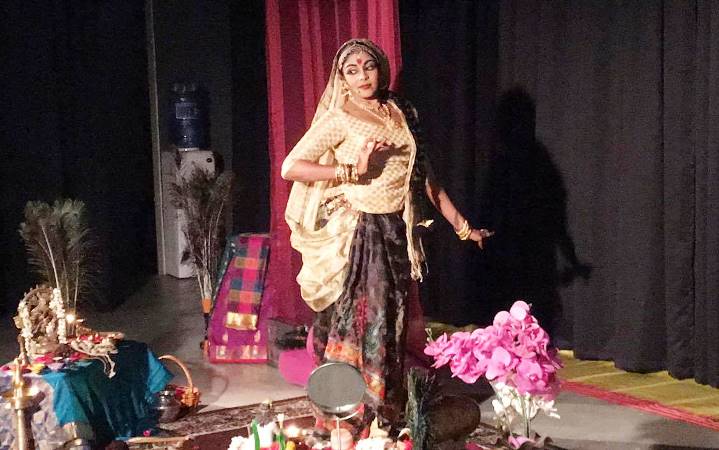SHE moved with grace, commanding the stage with her artistry in playing male and female roles in the monodrama, Crimson Curtain.
Dancer Sandhya Manoj brought Lam Ghooi Ket’s original play of a devadasi to life, with flashes of brilliance that kept the drama going to the end.
The audience of 60, seated on the mat-covered floor, or on foldable chairs in the Geethashankaran Dance studio in Brickfields that April 22 afternoon, was kept rapt by Sandhya’s performance of the devadasi Vasundhara, in the year 1868, who reflects on her life.
The story, as told by Sandhya, is about Vasundhara who was sold to a devadasi by her poor parents.
The little girl, while sad to part from her parents, was bowled over by her new mistress’s opulent home.
Given the name Vasundhara, she learnt the dances and songs required to be a devadasi, and eventually became good enough to catch the eye of a prince who sends his representative to get Vasundhara – all of 16 then — to appear at his palace.
Her mistress is thrilled, as the right outcome would see her sitting pretty in her dotage. It was a time when the need for devadasis as handmaidens to the gods were waning in India. Traditionally, devadasis had a high status in society. They married rich patrons and spent their time honing their skills instead of becoming a housewife.
But Vasundhara was put off by the oily prince, to her mistress’s utter chagrin. The teenager must then dance and sing to keep her and her mistress in clover.
Soon enough, she falls in love with a man, and has the time of her life. But he has to leave, due to family constraints, and Vasundhara is left to mend her broken heart, and find her way in the world with her talents.
In telling how Vasundhara ended up being sold, Sandhya played the little girl’s mother, father, the girl, and her mistress.
As her life took on maturity, Sandhya offered her portrayals of Vasundhara’s suitors, the devadasi – old and young — and the prince’s shyster representative.
She did all this through strong vocal pitches and body language with definite effect.
With evocative style using face, voice, and gestures, Sandhya showed the moods and emotions of a devadasi who was once revered as a handmaiden of the gods, only to become another common courtesan as she reached full maturity.
Vasundhara tries to reconcile her lot in life, with an open-ended dilemma offered with stoic despair at the end of the 100-minute performance.
The choreography of dance and movements, by Geetha, was tight which helped deliver the tensions and nuances of the wordsome tale.
Music interspersed the monodrama, played by violinist Hariraam Tingyuan Lam, with occasional vocals by Sandhya. A change of costume in the performance saw Hariram coaxing the audience in a sing-along of the famous song, Bhagyada Lakshmi Baramma, composed by Purandara Dasaru.
Kudos to Sandhya who played the roles with dramatic intent, even if she needed a few prompts from Lam for some lines.
It was a revelation to find a dancer who is so versatile — to be able to more than carry a tune, and express not just through face and gestures but with voice too.
Lam waited a decade for the right performer for his original script, with good measure.
In the intimate atmosphere of the studio, Sandhya reached the corners with her dramatic talents. However, whether the monodrama will translate from its current setting to a larger stage remains to be seen.
Pictures by Subhadra Devan
** This review appeared in New Sunday Times’ Vibes section.


